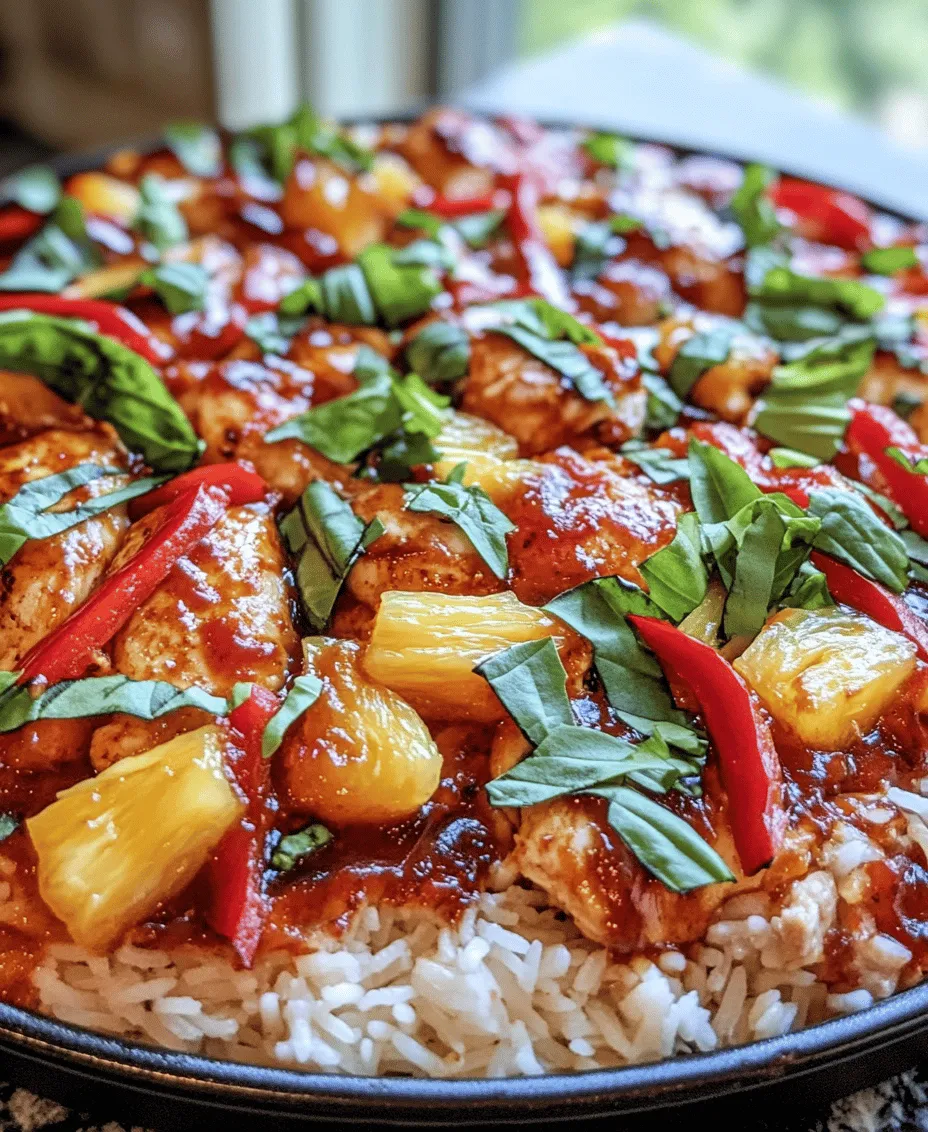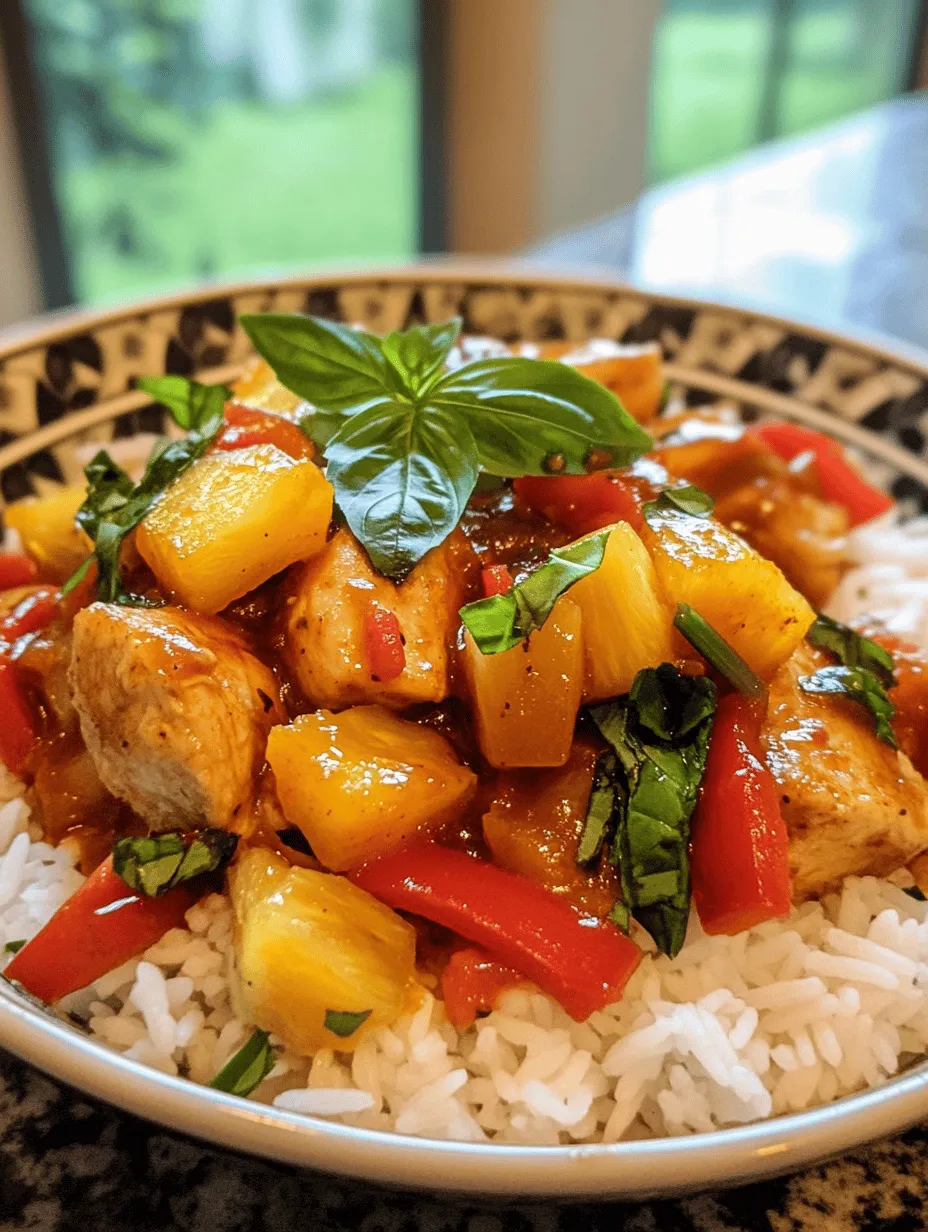Introduction
Thai cuisine is celebrated worldwide for its vibrant flavors, aromatic spices, and colorful presentations. Known for its harmonious balance of sweet, sour, salty, and spicy elements, Thai food offers a culinary experience that tantalizes the taste buds and delights the senses. One dish that encapsulates these unique characteristics is Sweet and Spicy Thai Chicken, a perfect fusion of sweet and savory that has gained popularity in both home kitchens and restaurants alike.
This recipe brings together tender chicken, vibrant vegetables, and a blend of savory sauces, resulting in a dish that is not only delicious but also versatile enough to serve on busy weeknights or special occasions. Imagine coming home after a long day and whipping up a meal that feels indulgent yet is easy to prepare. The Sweet and Spicy Thai Chicken is just that—a quick, flavorful option that can impress your family or guests without requiring hours in the kitchen.
In this article, we will take a deep dive into the ingredients that make this dish unique and provide detailed preparation steps to ensure your chicken turns out perfectly every time. Whether you are a seasoned chef or a novice cook, this recipe will guide you through each step, making it an enjoyable cooking experience.
Understanding the Ingredients
The success of any recipe lies in the quality and combination of its ingredients. For our Sweet and Spicy Thai Chicken, we will use a range of fresh and flavorful components that contribute to the dish’s overall appeal. Let’s break down each ingredient and explore its role in the recipe.
Boneless, Skinless Chicken Thighs
When it comes to the protein in this dish, boneless, skinless chicken thighs are the preferred choice. Unlike chicken breasts, which can dry out easily, chicken thighs are more forgiving during the cooking process. They offer a richer flavor and remain juicy, making them ideal for stir-frying. The higher fat content in thighs enhances the overall taste of the dish, allowing them to absorb the sweet and spicy flavors of the sauce beautifully.
Vegetable Oil
Vegetable oil is essential in stir-frying, serving as the medium that allows the ingredients to cook evenly while preventing them from sticking to the pan. It has a high smoke point, making it suitable for the high temperatures often used in Thai cooking. You can also experiment with other oils, such as peanut or canola oil, to add subtle flavor variations.
Aromatics: Onion, Garlic, and Ginger
Aromatics are the backbone of many Thai dishes, and in our Sweet and Spicy Thai Chicken, onion, garlic, and ginger play a crucial role in building depth of flavor.
– Onion provides a sweet and savory base, enhancing the overall taste profile of the dish.
– Garlic adds a pungent, earthy aroma that complements the sweetness of the chicken.
– Ginger contributes a warm, zesty note that balances the sweetness with its slight spiciness.
When sautéed together, these aromatics create a fragrant foundation that elevates the dish.
Vegetables: Bell Pepper and Pineapple
For this recipe, we will use bell peppers and pineapple, which are not only flavorful but also offer nutritional benefits.
– Bell Peppers are packed with vitamins A and C, adding crunch and a sweet note that contrasts beautifully with the other ingredients.
– Pineapple introduces a tropical sweetness and acidity that perfectly complements the savory elements of the dish. Its natural sugars caramelize during cooking, enhancing the overall flavor profile.
These vegetables add both texture and color to the dish, making it visually appealing while contributing essential nutrients.
Sauces: Soy Sauce and Fish Sauce
The sauces used in this recipe are critical for achieving that authentic Thai flavor.
– Soy Sauce serves as a salty base that deepens the flavor of the chicken and vegetables. It adds umami, making the dish more satisfying.
– Fish Sauce is a staple in Thai cooking, known for its pungent aroma and salty flavor. Just a small amount brings a depth of flavor that cannot be replicated with other ingredients. While it may seem intimidating at first, fish sauce is essential for that authentic Thai taste.
Seasonings: Brown Sugar, Rice Vinegar, and Thai Chili Paste
To achieve the characteristic sweet and spicy balance, we will incorporate brown sugar, rice vinegar, and Thai chili paste into our recipe.
– Brown Sugar adds a rich sweetness that balances the saltiness of the soy and fish sauces. The molasses content in brown sugar also provides a depth of flavor that white sugar cannot match.
– Rice Vinegar introduces acidity, which brightens the dish and cuts through the sweetness, creating a well-rounded flavor profile.
– Thai Chili Paste is where the heat comes from in this recipe. This versatile paste is made from a blend of dried chilies, garlic, and spices, providing not only heat but also a complex flavor that enhances the overall dish.
Fresh Herbs: Basil
To finish the dish, fresh basil is added for garnish. Thai basil, in particular, has a distinctive flavor that is slightly spicy and aromatic, making it a perfect complement to the Sweet and Spicy Thai Chicken. Not only does basil enhance the flavor, but it also provides health benefits, including anti-inflammatory properties and essential vitamins.
Preparation Steps in Detail
Now that we have a clear understanding of the ingredients, let’s detail the preparation steps to ensure your Sweet and Spicy Thai Chicken turns out perfectly.
Step 1: Seasoning the Chicken
Start by seasoning the boneless, skinless chicken thighs. It’s essential to ensure the chicken is well-flavored before cooking. A simple seasoning of salt and pepper is a good start, but you can also add a tablespoon of soy sauce or a sprinkle of garlic powder to enhance the flavor further. Allow the chicken to marinate for at least 15 minutes to absorb the seasonings.
Step 2: Sautéing the Aromatics
In a large skillet or wok, heat 2 tablespoons of vegetable oil over medium-high heat. Once the oil is shimmering, add the chopped onion, minced garlic, and grated ginger. Sauté these aromatics for about 2-3 minutes, or until the onion becomes translucent and fragrant. Be cautious not to burn the garlic, as it can turn bitter if overcooked.
Step 3: Cooking the Chicken
Once the aromatics are ready, push them to one side of the pan and add the seasoned chicken thighs. Cook the chicken for about 5-7 minutes on each side or until golden brown and cooked through. The key to perfectly cooked chicken is to avoid overcrowding the pan; if necessary, cook in batches to ensure even cooking.
Step 4: Incorporating Vegetables
After the chicken is cooked through, add the sliced bell peppers and chunks of pineapple to the skillet. Stir-fry the mixture for an additional 3-4 minutes until the vegetables are tender yet still crisp. This step not only adds great texture but also allows the flavors of the chicken and vegetables to meld together.
Step 5: Making the Sauce
In a small bowl, whisk together the soy sauce, fish sauce, brown sugar, rice vinegar, and Thai chili paste. Pour this sauce over the chicken and vegetables in the skillet, stirring to coat everything evenly. Allow the mixture to simmer for 2-3 minutes, letting the sauce thicken slightly and the flavors develop. Taste the sauce and adjust the seasoning as needed, adding more sugar for sweetness or more chili paste for heat, depending on your preference.
Step 6: Finishing Touches
Once the sauce has thickened and the chicken is fully coated, remove the skillet from heat. Toss in a handful of fresh basil leaves just before serving. The residual heat will wilt the basil slightly, releasing its aromatic oils without losing its vibrant color.
By following these steps, you will create a delicious Sweet and Spicy Thai Chicken that is bursting with flavor. This dish not only showcases the unique flavor profiles of Thai cuisine but also offers a satisfying meal that can be enjoyed any day of the week.
Stay tuned for the next part of this article, where we will delve into additional tips for achieving the best results with your Sweet and Spicy Thai Chicken and answer some common questions that may arise during the cooking process.

Cooking Methods: Stir-Fry Technique and Its Benefits
Stir-frying is a quintessential cooking method in many Asian cuisines, particularly Thai, where it thrives due to its efficiency and ability to preserve the vibrant colors and crisp textures of vegetables. This technique involves cooking food quickly in a small amount of oil over high heat while continuously stirring. The benefits of stir-frying are manifold.
First, it allows for rapid cooking, which not only maintains the nutrients in the ingredients but also intensifies their flavors. The high heat caramelizes sugars in the food, creating a delightful depth of flavor that is characteristic of dishes like Sweet and Spicy Thai Chicken. Additionally, the quick cooking time ensures that the proteins, such as chicken, become juicy and tender, while vegetables retain their crunch, making for a dish that is both visually appealing and satisfying to eat.
To achieve the best results with stir-frying, it is essential to prepare all ingredients ahead of time. This includes cutting the chicken into bite-sized pieces, chopping vegetables, and measuring out sauces and spices. Once the cooking begins, everything should be ready to go, as the process moves quickly.
Serving Suggestions
Ideal Pairings for Sweet and Spicy Thai Chicken
Sweet and Spicy Thai Chicken is a versatile dish that pairs beautifully with various accompaniments, enhancing its flavor profile. One classic pairing is with steamed jasmine rice, which serves as a perfect backdrop to the dish’s bold flavors. The fluffy, aromatic rice absorbs the sauce, allowing you to savor every bite fully.
Serving with Jasmine Rice: Best Rice Options and Cooking Methods
Jasmine rice, known for its fragrant aroma and slightly sticky texture, is the ideal rice choice for this dish. To cook jasmine rice perfectly, start by rinsing it under cold water to remove excess starch, which can make the rice gummy. Use a ratio of 1 cup of rice to 1.5 cups of water. Bring the water to a boil, then reduce the heat to low, cover, and simmer for about 15 minutes or until the water is absorbed. Let the rice sit, covered, for another 5 minutes before fluffing with a fork.
For a twist, consider coconut rice—cooked in coconut milk instead of water, which adds a rich, creamy flavor that complements the dish’s sweetness.
Suggestions for Side Dishes that Complement the Main Dish
In addition to jasmine rice, consider serving Sweet and Spicy Thai Chicken with a variety of side dishes that complement its flavors. A fresh cucumber salad dressed with lime juice and a sprinkle of chili flakes can provide a refreshing contrast to the richness of the chicken.
Another excellent side option is Thai spring rolls filled with fresh vegetables and herbs, served with a sweet chili dipping sauce. This adds a delightful crunch and an additional layer of flavor to your meal. You can also serve a simple stir-fried vegetable medley—such as bell peppers, broccoli, and snap peas—seasoned with garlic and ginger for added depth.
Nutritional Benefits of the Dish
Sweet and Spicy Thai Chicken not only tantalizes the taste buds but also offers an impressive nutritional profile.
Overview of the Nutritional Profile
The primary ingredient, chicken, is an excellent source of lean protein crucial for muscle growth and repair. A typical serving of this dish contains around 30 grams of protein, making it a satisfying option for those seeking to increase their protein intake.
Vitamins and Minerals from Vegetables and Pineapple
The inclusion of colorful vegetables like bell peppers, carrots, and snap peas contributes a wealth of vitamins and minerals. These vegetables provide essential vitamins A and C, which are vital for maintaining healthy skin and supporting the immune system. Pineapple, often featured in the sauce, adds a natural sweetness while offering bromelain, an enzyme that aids digestion and reduces inflammation.
Health Benefits of Fresh Herbs and Spices
Additionally, the fresh herbs and spices used in the recipe—such as cilantro, garlic, and ginger—bring their own health benefits. Garlic is known for its immune-boosting properties, while ginger can help with digestion and has anti-inflammatory effects. The combination of these ingredients not only enhances the flavor but also contributes positively to overall health.
Cultural Significance of Thai Cuisine
Thai cuisine is celebrated worldwide for its vibrant flavors and unique combinations of ingredients. The balance of sweet, sour, salty, and spicy is a hallmark of Thai cooking, creating dishes that are both complex and harmonious.
The Balance of Flavors in Thai Cooking
This balance stems from the use of fresh ingredients and traditional cooking techniques that elevate the natural flavors of the food. In Sweet and Spicy Thai Chicken, the sweetness of pineapple and sugar balances the heat from the chili peppers, while the salty soy sauce and tangy lime juice add depth and brightness.
The Importance of Family and Communal Dining in Thai Culture
Moreover, Thai cuisine is deeply rooted in culture and tradition, emphasizing communal dining. Meals are often shared, with various dishes placed in the center of the table for everyone to enjoy together. This practice fosters connection and brings families closer, making meals not just about sustenance but also about community and togetherness.
Variations and Adaptations
One of the fantastic aspects of Sweet and Spicy Thai Chicken is its flexibility, allowing for numerous variations to cater to different dietary preferences.
Suggestions for Customizing the Recipe
For those who prefer a vegetarian or vegan option, tofu or tempeh can be substituted for chicken. Both alternatives absorb flavors well and provide a satisfying texture. For a gluten-free version, ensure that the soy sauce is gluten-free or opt for tamari.
Adjusting Spice Levels for Different Palates
Additionally, you can easily adjust the spice levels in the dish. If you prefer a milder flavor, reduce the amount of chili paste or use a milder variety of peppers. Conversely, if you enjoy heat, consider adding extra sliced chili peppers or a dash of chili oil for an added kick.
Alternative Vegetables Based on Seasonality
You can also experiment with different vegetables based on what’s in season. Seasonal vegetables like zucchini, asparagus, or bok choy can be excellent additions, providing freshness and variety to the dish.
Conclusion
Sweet and Spicy Thai Chicken is not just a meal; it’s an experience that transports your taste buds to the streets of Thailand with every bite. Its vibrant flavors, nutritional benefits, and cultural significance make it a standout dish that appeals to a wide range of palates. The versatility of this recipe allows for customization, making it suitable for various dietary preferences, while the simple stir-fry technique ensures that anyone can recreate it in their kitchen.
Whether enjoyed alone or shared with loved ones, this dish embodies the essence of Thai cuisine—delicious, colorful, and brimming with life. So, gather your ingredients, unleash your inner chef, and explore the delightful flavors of Thai cooking in your own home.



